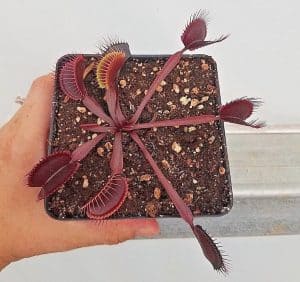Venus flytraps have very distinct colors. The leaves are green, and the inside of its traps is reddish. The green and red colors are the original colors, but growers have developed other colors of Venus flytraps over the years. For example, a beautiful Red Venus flytrap clone has been developed. Akai Ryu is a variation of Venus flytraps that exhibits a deep red color over the whole leaves.
Today, we will explore its origin and main characteristics.
Red Venus flytrap: Origin
“Through breeding efforts in the support greenhouses of the Atlanta Botanical Garden, a new all red form of the Venus Flytrap (Dionaea muscipula) has been created. The parents of this new cultivar were an all red form (female) and a “toothless” or fine tooth form (male) of Dionaea muscipula. The all red parent is apparently the same clone that was isolated by Mr. Theo de Groot in Holland over a decade ago and has been in limited cultivation here in the United States since. The toothless form was originally isolated by Mr. Thomas Carow in Nudlingen, Germany. Twenty (20) viable seeds were collected and of these, seven clones were established in issue culture.” (Ron Gagliardo, A New Cultivar of Dionaea muscipula Ellis, Carnivorous Plant Newsletter)
What is a cultivar? A cultivar is a cultivated variety of a particular plant. Cultivated Varieties do not develop in the wild; humans develop them. You can explore and learn about different venus flytrap cultivars in the International Carnivorous Plant Society (ICPS) website.
Description

The red Venus flytrap was named Akai Ryu, which in Japanese means: Red Dragon. Physically, the red dragon looks very similar to any Venus flytrap. However, its color is unique. The inside and outside of the leaves are maroon. The only visible part of the plant that is not red is the flowers. When a red Venus flytrap flourishes in the spring, the flower stalks are green.
You might notice some of the leave in the picture on the right have green edges or green spots. This is entirely normal. With sufficient exposure to sunlight, these plants preserve the maroon color ultimately. However, sometimes you might see specs of green where the leaves are growing.
Where to Buy Red Venus Flytrap
Red Venus flytraps are a lot more uncommon than standard Venus flytraps. Usually, you can find Venus flytraps in some brick and mortar stores such as Walmart, Home Depot, and Ace. Since the Akai Ryu clone is rare, I would suggest searching online.
If you are thinking about buying a Red Dragon Venus flytrap, make sure you go over the care considerations below.
Care Considerations
Venus flytraps are unique plants and require particular care to thrive. Generally, when growing them at home, you try to replicate their natural habitat.
Here is a summary list of care instructions to grow healthy Venus flytraps.
Water: Venus flytraps need tons of water. When in doubt, always water. The soil needs to be moist at all times. Also, you can only use rainwater, reverse osmosis water, or distilled water. Venus flytraps can’t handle minerals or salt. Therefore, they need mineral/salt-free water.
Light: Venus flytraps require an abundance of sunlight. Place them in a strategic spot, where they can receive 12 hours of sun a day. Venus flytraps can also live in partial shade, but they need at least 4-5 hours of direct sunlight.
Feeding: Venus flytraps do not need to be fed bugs to survive (here is an explanation: Can Venus Flytraps live without bugs?). However, they won’t thrive without been fed. The goal should be to feed your Venus flytrap once every two weeks or once every month. For more information, you can read our complete guide on how to feed a Venus flytrap:
Soil: Similarly to their water requirement, Venus flytraps require nutrient-free soil with good drainage. Long-fibered sphagnum moss and sphagnum peat moss are both suitable options.
Fertilizer: Even if it is counter-intuitive, do not fertilize your Venus flytrap. These plants originate in poor soil habitats. You can kill your plant with fertilizers.
Indoor Living: You can grow Venus flytraps in an indoor environment. Still, you must make sure you can find an indoor area that can fulfill all the other environmental considerations.
This care instruction list points you in the right direction. However, there are many other essential care considerations. Read the article below for a complete overview: Complete Care Guide.
Related Questions
Do blue Venus flytraps exist?
No. Unfortunately, some very appealing photos of blue Venus flytraps have become popular through the web. Some online vendors advertise blue Venus flytrap seeds or plants. But, they are scams. They might deliver seeds or plants, but they won’t be of the promised color.
Still, do not get discouraged. You can buy a traditional Venus flytrap and enjoy the green and red colors or be more adventurous and grow a Red Dragon.
Do the Venus flytrap colors changes over time?
The colors in Venus flytraps change due to environmental conditions. A healthy plant should exhibit bright green leaves with a deep red interior. Usually, plants display lighter colors when they do not get appropriate sunlight.
Is the Venus flytrap “Red Dragon” the same as the “Red Piranha”?
No, they are two different types of cultivars. The Dionaea Red piranha is a clone hybrid between the Red Dragon and the Dionaea “Dente.” The Dente clone characterizes with short triangular teeth.
Sources
- D’Amato, P. (2013). The Savage Garden. Berkeley, Unites States: Ten Speed Press.
- https://legacy.carnivorousplants.org/cpn/Species/v25n2p50.html

